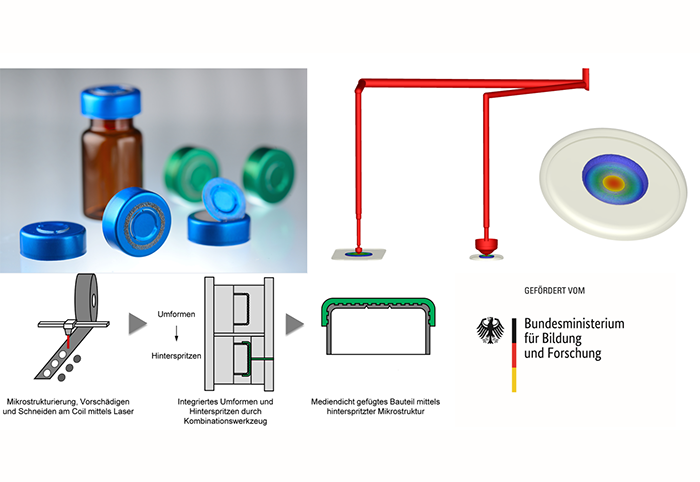
MeKuMed - Manufacturing of hybrid medical technology products by means of an innovative production chain
ESPECIALLY FOR OUR USERSThe MeKuMed project, which started in 2021, is now going into its "final phase" so to speak. In this project SimpaTec together with other project partners have investigated the process optimization of pharmaceutical crimp caps to reduce a 5 step process to one. One of the main criteria of the product is that the plastic and metal cap are sealed up to the point where the medical professional removes the plastic cap. Injection molding simulations were performed with high accuracy using Moldex3D to visualize the filling of the plastic melt in structures of 10 microns.
The MeKuMed project "Materials-compatible and cost-effective production of metal/plastic hybrid components for use in medical technology" is funded by the BMBF. Participating project partners are: KraussMaffei Technologies GmbH, Fraunhofer Institute for Laser Technology (ILT), Institute for Plastics Processing (IKV) at RWTH Aachen University, Röchling Medical Brensbach GmbH, Pulsar Photonics GmbH and Werkzeugbau Siegfried Hofmann GmbH.
When products made of different materials the potential of the individual materials and their interaction in the hybrid is only partially exploited. The pharmaceutical crimp closure is an example of such a hybrid product. The ampoule filled with medication is sealed airtight and sterile with a rubber stopper. The rubber stopper is fixed in the ampoule by the flare closure. The combination of thin aluminum sheet and plastic meets the requirements for the product. The production chain consists of five separate individual steps, resulting in a high number of handling and cleaning steps and high demands on machines and tools.
The aim of this project is to produce a form-fit connection by back molding microstructured aluminum caps in a 4-cavity mold with hot runners. In the process, the plastic flows into the undercut microstructures and creates a media-tight, defined releasable connection. Moldex3D was used to perform injection molding simulations at various stages of design and process optimization in the project. Very fine meshing was required to observe the flowability of the plastic melt in the microstructures. To reduce the computational cost, a 1/4-channel symmetry simulation was modeled. During the simulations, it was found that the melt flows better in the structures at a certain distance between them. In the next phase, we will use Moldex3D to optimize the parameters of the injection molding process.
